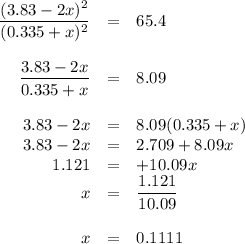
Chemistry, 11.03.2020 22:26 gshreya2005
At 500 °C, hydrogen iodide decomposes according to 2 HI ( g ) − ⇀ ↽ − H 2 ( g ) + I 2 ( g ) For HI ( g ) heated to 500 °C in a 1.00 L reaction vessel, chemical analysis determined these concentrations at equilibrium: [ H 2 ] = 0.335 M , [ I 2 ] = 0.335 M , and [ HI ] = 2.83 M . If an additional 1.00 mol of HI ( g ) is introduced into the reaction vessel, what are the equilibrium concentrations after the new equilibrium has been reached?

Answers: 1


Other questions on the subject: Chemistry

Chemistry, 21.06.2019 23:30, robertotugalanp1wlgs
Why do you suppose the structural polysaccharide cellulose does not contain branches? why do you suppose the structural polysaccharide cellulose does not contain branches? branches in the molecule would generate side chains that would almost certainly make it difficult to pack the cellulose molecules into globules, thereby decreasing the flexibility and strength of the globules. branches in the molecule would generate side chains that would almost certainly make it difficult to pack the cellulose molecules into microfibrils, thereby increasing the rigidity and strength of the microfibrils. branches in the molecule would generate side chains that would almost certainly make it difficult to pack the cellulose molecules into globules, thereby increasing the flexibility and strength of the globules. branches in the molecule would generate side chains that would almost certainly make it difficult to pack the cellulose molecules into microfibrils, thereby decreasing the rigidity and strength of the microfibrils.
Answers: 1

Chemistry, 22.06.2019 05:30, madisonrosamond99
Astudent carefully transfers 30 g of water and 30 g of alcohol in a glass tube, forming two layers and filling the tube completely. after sealing the tube, the student mixes the solutions, and notices a bubble that forms in the tube. what is the mass of the contents in the glass tube after mixing?
Answers: 2

Chemistry, 22.06.2019 09:00, pinapunapula
Which explanation is true about what happens to a ray of light when it strikes a mirror? a. a light ray is transmitted toward a mirror at a certain angle. the light ray is then reflected by the mirror at an equal angle but in the opposite direction of the transmitted ray. b. an incident ray strikes a mirror at an angle with a line perpendicular to the mirror. the light ray is then reflected at an angle equal to the angle of incidence but on the opposite side of the perpendicular line. c. a reflecting ray strikes a mirror at an angle with a line perpendicular to the mirror. the light ray is then refracted at an angle equal to the angle of the reflecting ray and on the same side of the perpendicular line. d. an incident ray strikes a mirror at an angle with a line parallel to the mirror. the light ray is then transmitted at an angle equal to the angle of incidence but on the opposite side of the parallel line. you so much! : -d take the time to try and answer correctly.
Answers: 3

Chemistry, 22.06.2019 18:00, ambarpena14
An object displaces 652 ml of water. the volume of the object is: 0.652 cm³ 6.52 cm³ 65.2 cm³ 652 cm³
Answers: 2
You know the right answer?
At 500 °C, hydrogen iodide decomposes according to 2 HI ( g ) − ⇀ ↽ − H 2 ( g ) + I 2 ( g ) For HI (...
Questions in other subjects:










Mathematics, 11.02.2020 20:22

![K_{\text{eq}} = \dfrac{\text{[HI]$^{2}$}}{\text{[H$_{2}]$[I$_{2}$]}} = \dfrac{2.83^{2}}{0.335 \times 0.335} = 65.4](/tpl/images/0543/5148/5b908.png)

![K_{\text{c}} = \dfrac{\text{[HI]$^{2}$}}{\text{[H$_{2}$][I$_2$]}} = \dfrac{(3.83 - 2x)^{2}}{(0.335 + x)^{2}} = 65.4](/tpl/images/0543/5148/b1d26.png)




